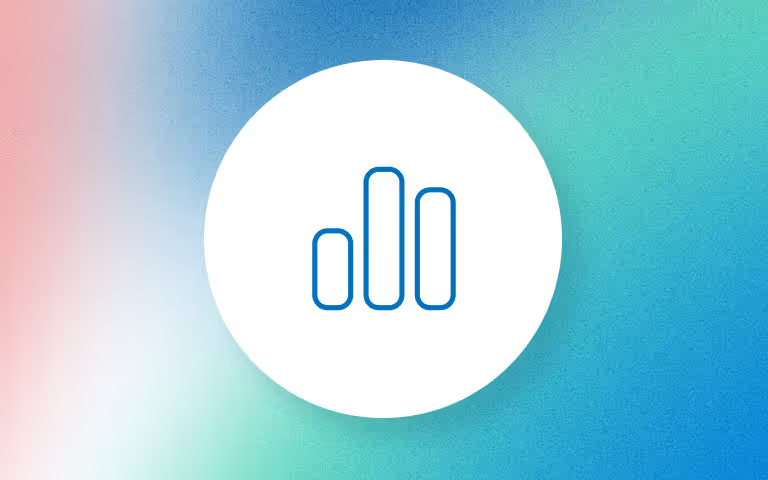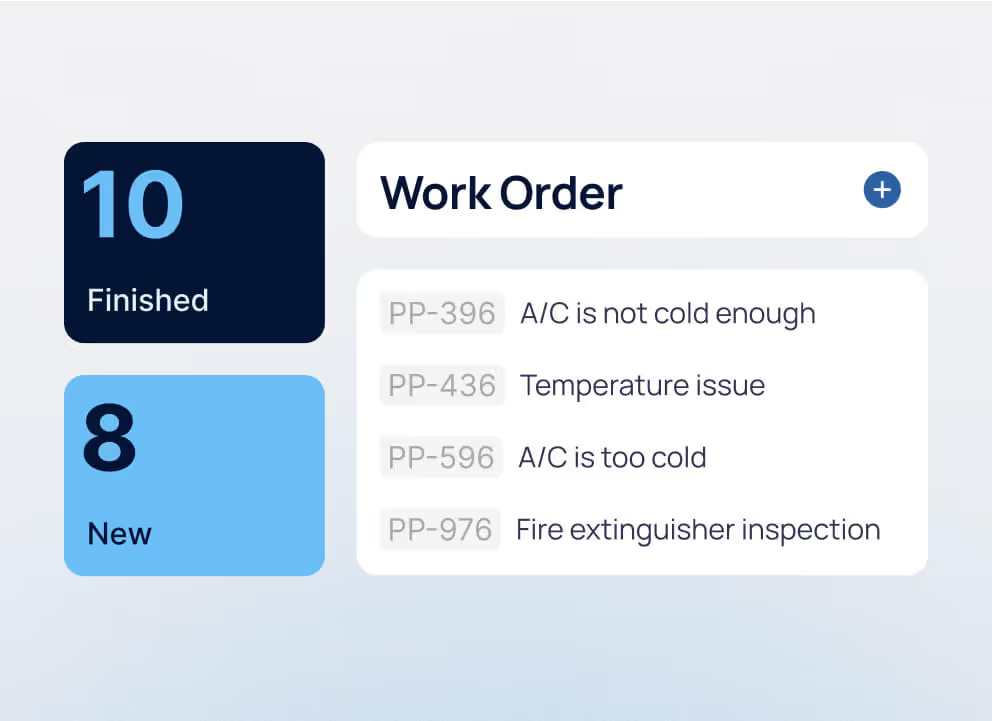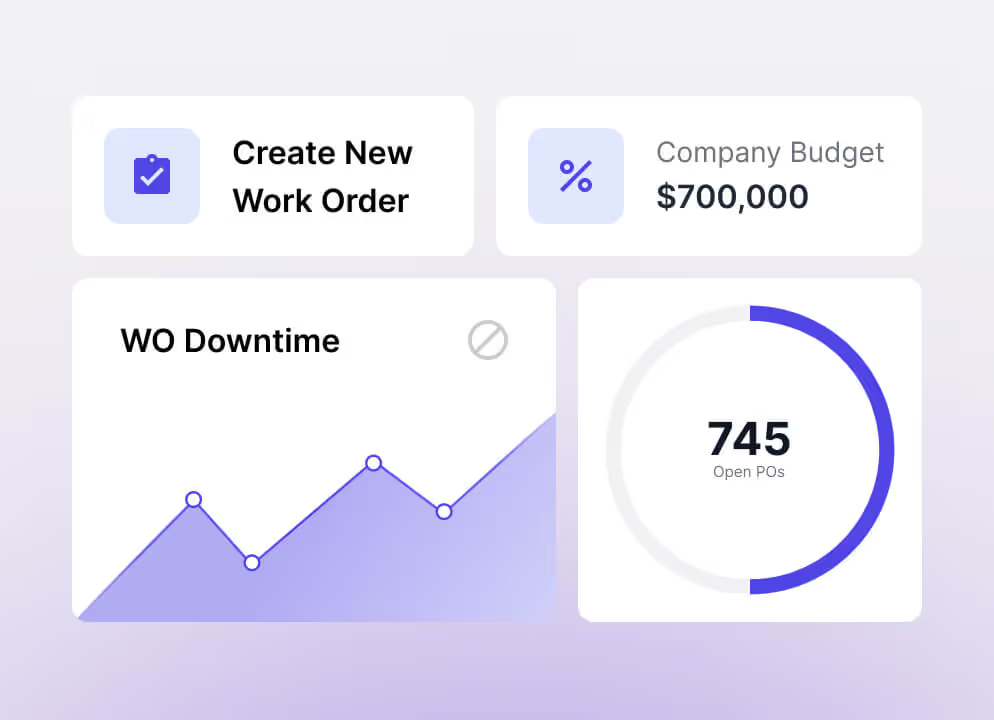Using Key Performance Indicators to Track Asset Criticality
In this post
%20(1).avif)
1
2
3
Three steps to better your maintenance program by determining the criticality of your organization’s assets and equipment using key performance indicators.
Using Key Performance Indicators to Track Asset Criticality
Smart facility managers know that all assets are not created equal, but determining which assets are critical to the operation of your company can be challenging. Key performance indicators (KPIs) will help you rank asset criticality and create a maintenance strategy to optimize asset performance and reduce costs and risks.
Key Performance Indicators (KPIs) for Maintenance Management
Process-related key performance indicators are known as “Leading KPIs”. A well-developed maintenance process forms the foundation for all organizational maintenance functions. Examples of leading key performance indicators:
- Business goals and objectives
- Identification of maintenance work processes
- Work planning and scheduling
- Execution of maintenance activities
- Maintenance follow-up and analysis
The actual results of your maintenance activities are known as “Lagging Key Performance Indicators”. Lagging KPIs vary depending on your industry and facility-type but typically fall under these general categories:
- Asset performance
- Reliability and efficiency ratings
- Repair and failure rates
- Life cycle costs
- Safety issues and risks
- Regulatory compliance
- Human safety and well-being
- Environmental issues and risks
- Business objectives, including ROI
Using KPIs to Determine Asset Criticality
Regardless of the maintenance strategy you currently employ, knowing which assets are critical to your operation and why can optimize operational ROI and reduce costs and risks. Ranking asset criticality depends on your individual facility's operation and objectives.
Step One:
Using these business attributes, assign each asset a characteristic a rating from zero to 10, with the total not to exceed 100 for each asset.
- Mission and customer impact
- Safety and environmental impact
- Single-point-failures isolation
- Preventive Maintenance (PM) history
- Corrective Maintenance (CM) history
- Failure Probability
- Spare parts lead time
- Asset replacement value
- Planned utilization rate
Step Two:
Once you have identified the top 15%-20% of your critical assets from Step One determine the primary characteristic that makes each asset critical. The asset data from your computerized maintenance management system (CMMS), provides asset life cycle costs, repair history, failure modes, and more-depending on your system type-and should provide relevant data.
Step Three:
By analyzing the asset data from the CMMS, particularly the single-point failure rating, you can adjust your maintenance approach to these critical assets, lowering their criticality ranking and reducing your overall risk.
Every facility manager has a "worse asset nightmare”, an asset failure that has serious or catastrophic consequences. By using this ranking system and the pertinent KPIs, you can create an effective asset maintenance plan. A proactive management strategy, like a Reliability-Centered Maintenance (RCM) approach, offers the best opportunity to align your maintenance management with organizational goals and objectives. You can prevent and even predict failure modes and optimize asset function and integrity.
Use the CMMS Key Performance Indicators to Manage Asset Criticality
A CMMS can help you track, measure, and prioritize your maintenance management activities:
Scheduling preventive maintenance (PM) tasks can ensure that assets are managed for optimal performance, including re-assigning and re-scheduling critical asset activities.
Monitoring failure modes and MTBF rates allow you to plan for timely asset replacements before they fail or to ensure adequate inventory is on hand to minimize downtime.
- Scheduling preventive maintenance (PM) tasks can ensure that assets are managed for optimal performance, including re-assigning and re-scheduling critical asset activities.
- Monitoring failure modes and MTBF rates allow you to plan for timely asset replacements before they fail or to ensure adequate inventory is on hand to minimize downtime.
- Managing materials and tracking spare parts inventory through your CMMS can prevent repair backlogs or costly production delays.
- Adopting a continuous improvement methodology with failure analysis, asset reports, and life-cycle costing data; important tools for maintenance "best practices".
Setting up and using key performance indicators lets you plan, track, and measure asset activity and performance. With an accurate picture of what assets are critical to your organization, you can make sound asset management decisions for both short-term and long-term goals and objectives. Adopting a "plan, improve, control" approach is the best way to ensure optimal asset reliability at optimal cost.
The strategic use of KPIs considers the overall performance, cost and criticality of organizational assets helps a team to decide where to invest their money, time, and resources. Schedule a demo to learn more about how TMA Systems and WebTMA can help your team leverage KPIs to reduce costs and risk exposure.
- Focus maintenance efforts on the assets that matter most.
- Reduce risk and boost ROI by aligning strategy to asset criticality.
- Improve performance over time with KPI-driven insights and adjustments.

Download the eBook now
You’re all set!
Your eBook is on its way to your inbox. We hope it brings fresh insights and practical takeaways to help you get more from your maintenance operations.
Explore related resources
.avif)
.svg)
Three steps to better your maintenance program by determining the criticality of your organization’s assets and equipment using key performance indicators.
Using Key Performance Indicators to Track Asset Criticality
Smart facility managers know that all assets are not created equal, but determining which assets are critical to the operation of your company can be challenging. Key performance indicators (KPIs) will help you rank asset criticality and create a maintenance strategy to optimize asset performance and reduce costs and risks.
Key Performance Indicators (KPIs) for Maintenance Management
Process-related key performance indicators are known as “Leading KPIs”. A well-developed maintenance process forms the foundation for all organizational maintenance functions. Examples of leading key performance indicators:
- Business goals and objectives
- Identification of maintenance work processes
- Work planning and scheduling
- Execution of maintenance activities
- Maintenance follow-up and analysis
The actual results of your maintenance activities are known as “Lagging Key Performance Indicators”. Lagging KPIs vary depending on your industry and facility-type but typically fall under these general categories:
- Asset performance
- Reliability and efficiency ratings
- Repair and failure rates
- Life cycle costs
- Safety issues and risks
- Regulatory compliance
- Human safety and well-being
- Environmental issues and risks
- Business objectives, including ROI
Using KPIs to Determine Asset Criticality
Regardless of the maintenance strategy you currently employ, knowing which assets are critical to your operation and why can optimize operational ROI and reduce costs and risks. Ranking asset criticality depends on your individual facility's operation and objectives.
Step One:
Using these business attributes, assign each asset a characteristic a rating from zero to 10, with the total not to exceed 100 for each asset.
- Mission and customer impact
- Safety and environmental impact
- Single-point-failures isolation
- Preventive Maintenance (PM) history
- Corrective Maintenance (CM) history
- Failure Probability
- Spare parts lead time
- Asset replacement value
- Planned utilization rate
Step Two:
Once you have identified the top 15%-20% of your critical assets from Step One determine the primary characteristic that makes each asset critical. The asset data from your computerized maintenance management system (CMMS), provides asset life cycle costs, repair history, failure modes, and more-depending on your system type-and should provide relevant data.
Step Three:
By analyzing the asset data from the CMMS, particularly the single-point failure rating, you can adjust your maintenance approach to these critical assets, lowering their criticality ranking and reducing your overall risk.
Every facility manager has a "worse asset nightmare”, an asset failure that has serious or catastrophic consequences. By using this ranking system and the pertinent KPIs, you can create an effective asset maintenance plan. A proactive management strategy, like a Reliability-Centered Maintenance (RCM) approach, offers the best opportunity to align your maintenance management with organizational goals and objectives. You can prevent and even predict failure modes and optimize asset function and integrity.
Use the CMMS Key Performance Indicators to Manage Asset Criticality
A CMMS can help you track, measure, and prioritize your maintenance management activities:
Scheduling preventive maintenance (PM) tasks can ensure that assets are managed for optimal performance, including re-assigning and re-scheduling critical asset activities.
Monitoring failure modes and MTBF rates allow you to plan for timely asset replacements before they fail or to ensure adequate inventory is on hand to minimize downtime.
- Scheduling preventive maintenance (PM) tasks can ensure that assets are managed for optimal performance, including re-assigning and re-scheduling critical asset activities.
- Monitoring failure modes and MTBF rates allow you to plan for timely asset replacements before they fail or to ensure adequate inventory is on hand to minimize downtime.
- Managing materials and tracking spare parts inventory through your CMMS can prevent repair backlogs or costly production delays.
- Adopting a continuous improvement methodology with failure analysis, asset reports, and life-cycle costing data; important tools for maintenance "best practices".
Setting up and using key performance indicators lets you plan, track, and measure asset activity and performance. With an accurate picture of what assets are critical to your organization, you can make sound asset management decisions for both short-term and long-term goals and objectives. Adopting a "plan, improve, control" approach is the best way to ensure optimal asset reliability at optimal cost.
The strategic use of KPIs considers the overall performance, cost and criticality of organizational assets helps a team to decide where to invest their money, time, and resources. Schedule a demo to learn more about how TMA Systems and WebTMA can help your team leverage KPIs to reduce costs and risk exposure.
- Focus maintenance efforts on the assets that matter most.
- Reduce risk and boost ROI by aligning strategy to asset criticality.
- Improve performance over time with KPI-driven insights and adjustments.

Register for your free webinar
You’re all set!
Your webinar is on its way to your inbox. We hope it brings fresh insights and practical takeaways to help you get more from your maintenance operations.
Explore related resources
.avif)
.svg)

Using Key Performance Indicators to Track Asset Criticality
Smart facility managers know that all assets are not created equal, but determining which assets are critical to the operation of your company can be challenging. Key performance indicators (KPIs) will help you rank asset criticality and create a maintenance strategy to optimize asset performance and reduce costs and risks.
Key Performance Indicators (KPIs) for Maintenance Management
Process-related key performance indicators are known as “Leading KPIs”. A well-developed maintenance process forms the foundation for all organizational maintenance functions. Examples of leading key performance indicators:
- Business goals and objectives
- Identification of maintenance work processes
- Work planning and scheduling
- Execution of maintenance activities
- Maintenance follow-up and analysis
The actual results of your maintenance activities are known as “Lagging Key Performance Indicators”. Lagging KPIs vary depending on your industry and facility-type but typically fall under these general categories:
- Asset performance
- Reliability and efficiency ratings
- Repair and failure rates
- Life cycle costs
- Safety issues and risks
- Regulatory compliance
- Human safety and well-being
- Environmental issues and risks
- Business objectives, including ROI
Using KPIs to Determine Asset Criticality
Regardless of the maintenance strategy you currently employ, knowing which assets are critical to your operation and why can optimize operational ROI and reduce costs and risks. Ranking asset criticality depends on your individual facility's operation and objectives.
Step One:
Using these business attributes, assign each asset a characteristic a rating from zero to 10, with the total not to exceed 100 for each asset.
- Mission and customer impact
- Safety and environmental impact
- Single-point-failures isolation
- Preventive Maintenance (PM) history
- Corrective Maintenance (CM) history
- Failure Probability
- Spare parts lead time
- Asset replacement value
- Planned utilization rate
Step Two:
Once you have identified the top 15%-20% of your critical assets from Step One determine the primary characteristic that makes each asset critical. The asset data from your computerized maintenance management system (CMMS), provides asset life cycle costs, repair history, failure modes, and more-depending on your system type-and should provide relevant data.
Step Three:
By analyzing the asset data from the CMMS, particularly the single-point failure rating, you can adjust your maintenance approach to these critical assets, lowering their criticality ranking and reducing your overall risk.
Every facility manager has a "worse asset nightmare”, an asset failure that has serious or catastrophic consequences. By using this ranking system and the pertinent KPIs, you can create an effective asset maintenance plan. A proactive management strategy, like a Reliability-Centered Maintenance (RCM) approach, offers the best opportunity to align your maintenance management with organizational goals and objectives. You can prevent and even predict failure modes and optimize asset function and integrity.
Use the CMMS Key Performance Indicators to Manage Asset Criticality
A CMMS can help you track, measure, and prioritize your maintenance management activities:
Scheduling preventive maintenance (PM) tasks can ensure that assets are managed for optimal performance, including re-assigning and re-scheduling critical asset activities.
Monitoring failure modes and MTBF rates allow you to plan for timely asset replacements before they fail or to ensure adequate inventory is on hand to minimize downtime.
- Scheduling preventive maintenance (PM) tasks can ensure that assets are managed for optimal performance, including re-assigning and re-scheduling critical asset activities.
- Monitoring failure modes and MTBF rates allow you to plan for timely asset replacements before they fail or to ensure adequate inventory is on hand to minimize downtime.
- Managing materials and tracking spare parts inventory through your CMMS can prevent repair backlogs or costly production delays.
- Adopting a continuous improvement methodology with failure analysis, asset reports, and life-cycle costing data; important tools for maintenance "best practices".
Setting up and using key performance indicators lets you plan, track, and measure asset activity and performance. With an accurate picture of what assets are critical to your organization, you can make sound asset management decisions for both short-term and long-term goals and objectives. Adopting a "plan, improve, control" approach is the best way to ensure optimal asset reliability at optimal cost.
The strategic use of KPIs considers the overall performance, cost and criticality of organizational assets helps a team to decide where to invest their money, time, and resources. Schedule a demo to learn more about how TMA Systems and WebTMA can help your team leverage KPIs to reduce costs and risk exposure.


Related resources
Related resources
You’ve seen what’s possible—connect with us to learn how TMA Systems can support your goals beyond the event.
You’ve read the insights, now see how TMA Systems helps teams put them into practice.
From ideas to impact
You’ve read the insights, now see how TMA Systems helps teams put them into practice.
From screen to solution
You’ve watched what’s possible, now see how TMA Systems works for your organization.
From insight to implementation
You’ve explored the strategies, now see how we can bring them to life across your real facilities.
From insight to implementation
You’ve explored the strategies, now see how we can bring them to life across your real facilities.




.svg)

.avif)









